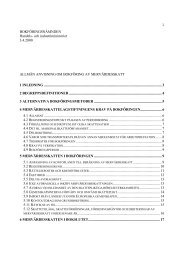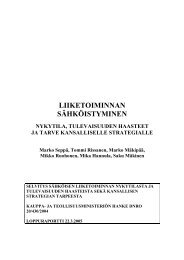Knowledge Intensive Services' Suppliers and Clients
Knowledge Intensive Services' Suppliers and Clients
Knowledge Intensive Services' Suppliers and Clients
Create successful ePaper yourself
Turn your PDF publications into a flip-book with our unique Google optimized e-Paper software.
25<br />
Individual manufacturing industries in the EU were clustered into groups sharing<br />
similarities with respect to use of KIBS <strong>and</strong> other inputs. 4 clusters of industries<br />
were distinguished:<br />
• high inputs of transport services<br />
• high inputs of retail <strong>and</strong> advertising services<br />
• high inputs of knowledge-based services<br />
• other industries.<br />
The analysis tended to reveal higher productivity <strong>and</strong> higher growth in value added<br />
for the third group of manufacturing industries in the EU. Lower declines in<br />
employment, <strong>and</strong> greater quality differentiation (lower price competition), were<br />
also noted for industries with high inputs of knowledge-based services.<br />
As noted, it would be valuable to extend this work with European clustering data;<br />
not least to see how far EU patterns of KIBS use correspond to those in the US. It<br />
might be hypothesised that stronger relations should be found where locally<br />
validated clusters are identified <strong>and</strong> employed. Service sectors might also be<br />
included in the cluster <strong>and</strong> subsequent analysis.<br />
But the general thrust of the data analysis tends to support the view that the use of<br />
KIBS enhances the performance o those sectors that consume more of them. The<br />
same conclusion is reached from a rather different set of IO approaches.<br />
Econometric estimations<br />
Several recent studies use IO data in production function analyses. Antonelli<br />
(2000) argues that KIBS contribute to innovation <strong>and</strong> thus to performance by<br />
enabling information flows that support learning <strong>and</strong> adaptation. (In addition to the<br />
classic tools for increasing innovation <strong>and</strong> absorption capacity of in-house R&D<br />
etc.).Two types of KIBS were differentiated (reflecting this emphasis on<br />
information flows): communication services <strong>and</strong> business services. The rates of<br />
growth in the use of these two types of knowledge service should be associated with<br />
increasing productivity among their users (again, at a sectoral rather than firm<br />
level). IO data for a number of European countries (Italy, UK, Germany, France<br />
<strong>and</strong> the Netherl<strong>and</strong>s) was tested, <strong>and</strong> demonstrated that in all five countries. The use<br />
of business <strong>and</strong> communication services was correlated with their rate of growth.<br />
(See Box 1) The correlation with use of communications <strong>and</strong> business services<br />
taken together was statistically significant for most countries (weak results for<br />
Germany <strong>and</strong> the Netherl<strong>and</strong>s). In analyses that only included either business or<br />
communication services, the results for the Netherl<strong>and</strong>s were again weak, while the
















